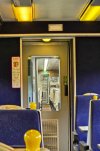Correct.
I've looked at other sources of information for the ES44AC and it's predecessor AC4400CW, which has basically the same electrical equipment and engine power.
If we assume the 'Tractive Effort (continuous): 166,000 lbs' is correct (as the loco can definitely produce that and more at very low speeds), taking the engine power 'available for traction' as 4400hp/3300kW and allowing for transmission efficiency, the balancing speed for that TE is around 9-10mph. 13.7mph is too high, as speed x TE => more power than the rated engine power. Also I've seen mentioned that the transition from the adhesion limited to power limited parts of the TE vs speed curve is about 8-10mph for an AC4400CW, which ties in with the 166,000 lbs (738kN) @ 9-10mph numbers.
As for dry versus wet rails performance, for the ES44AC/AC4400CW I've seen mentioned 40% dry and 35% wet 'factor of adhesion' (percentage of driving axle weights translated into tractive effort). From memory, a good classic DC drive is around 25% 'factor of adhesion'. Note the higher TE and power-at-rail performance of AC drives is a combination of things as hwl said in post #940.
(If anyone is interested in this stuff, the
November 2006 (US) Trains magazine has an article called 'CSX's Mountain Climbers'. It's about improving the low-speed TE performance, particularly in bad weather, of AC4400CW locos by increasing the weight to 196 tonnes and improving the traction control performance in varying rail conditions. At the end of the development program, each axle could produce up to 36,000lbs/160kN of TE with an overall loco limit (for coupler stress reasons) of 200,000lbs/890kN. I just find this a phenomenal level of steel wheel on rail performance...)


